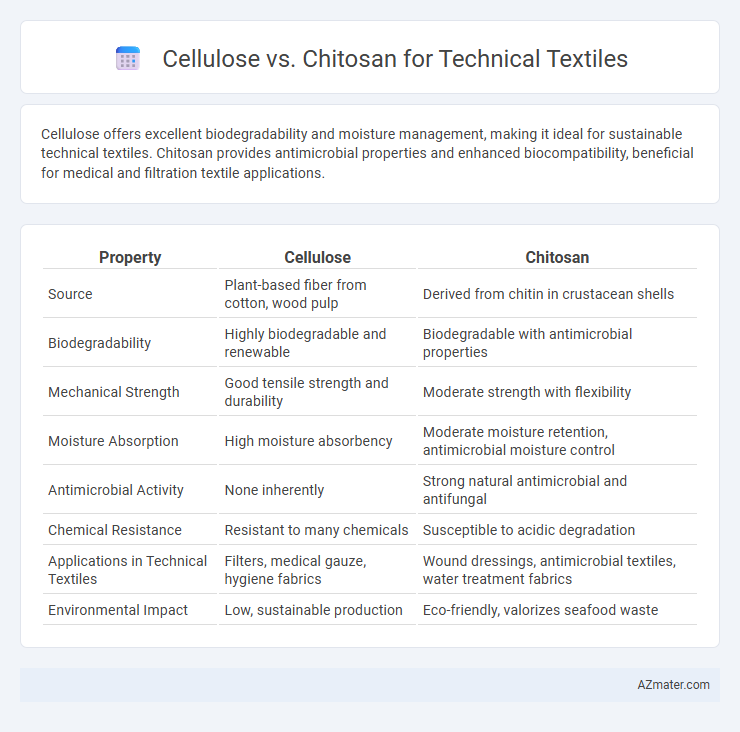Cellulose offers excellent biodegradability and moisture management, making it ideal for sustainable technical textiles. Chitosan provides antimicrobial properties and enhanced biocompatibility, beneficial for medical and filtration textile applications.
Table of Comparison
| Property | Cellulose | Chitosan |
|---|---|---|
| Source | Plant-based fiber from cotton, wood pulp | Derived from chitin in crustacean shells |
| Biodegradability | Highly biodegradable and renewable | Biodegradable with antimicrobial properties |
| Mechanical Strength | Good tensile strength and durability | Moderate strength with flexibility |
| Moisture Absorption | High moisture absorbency | Moderate moisture retention, antimicrobial moisture control |
| Antimicrobial Activity | None inherently | Strong natural antimicrobial and antifungal |
| Chemical Resistance | Resistant to many chemicals | Susceptible to acidic degradation |
| Applications in Technical Textiles | Filters, medical gauze, hygiene fabrics | Wound dressings, antimicrobial textiles, water treatment fabrics |
| Environmental Impact | Low, sustainable production | Eco-friendly, valorizes seafood waste |
Overview of Technical Textiles
Cellulose and chitosan are prominent biopolymers used in technical textiles due to their unique properties. Cellulose offers excellent moisture management, biodegradability, and mechanical strength, making it ideal for applications in medical textiles, filtration, and protective clothing. Chitosan provides antimicrobial activity and biocompatibility, enhancing performance in wound dressings, hygiene products, and advanced functional textiles.
Introduction to Cellulose Fibers
Cellulose fibers, derived from plant sources such as cotton, flax, and hemp, are widely used in technical textiles due to their biodegradability, high tensile strength, and moisture absorption properties. These natural polymers consist of long chains of glucose units, providing excellent mechanical stability and compatibility with various chemical treatments for enhanced performance. In comparison, chitosan fibers, sourced from crustacean shells, offer antimicrobial and biocompatible features but generally lack the mechanical robustness inherent to cellulose fibers for demanding textile applications.
Understanding Chitosan: Sources and Properties
Chitosan, derived from chitin found in crustacean shells, offers unique properties such as biodegradability, biocompatibility, and antimicrobial activity, making it a valuable alternative to cellulose in technical textiles. Unlike cellulose, sourced from plant fibers like cotton and wood pulp, chitosan enhances fabric functionality with moisture retention, film-forming ability, and improved dye affinity. The molecular structure of chitosan enables stronger interactions with synthetic fibers, providing superior performance in medical, filtration, and protective textile applications.
Comparative Physical Properties: Cellulose vs Chitosan
Cellulose exhibits high tensile strength, excellent moisture retention, and superior thermal stability, making it ideal for technical textiles requiring durability and comfort. Chitosan offers enhanced antimicrobial properties, biodegradability, and flexibility but has lower mechanical strength compared to cellulose. The comparative balance between cellulose's robustness and chitosan's bioactivity influences selection for applications such as protective clothing and medical textiles.
Mechanical Strength and Durability Assessment
Cellulose-based fibers exhibit high tensile strength and excellent dimensional stability, making them ideal for technical textile applications requiring mechanical robustness. Chitosan, derived from chitin, offers superior biocompatibility and antimicrobial properties but generally has lower mechanical strength and durability compared to cellulose. Combining cellulose with chitosan in composite fibers enhances fiber toughness and resistance to wear, extending the lifespan of technical textiles in industrial and medical uses.
Functional Finishes: Antimicrobial and Biodegradable Effects
Cellulose and chitosan play critical roles in technical textiles, especially regarding functional finishes with antimicrobial and biodegradable properties. Chitosan exhibits strong natural antimicrobial effects against bacteria and fungi, making it highly effective for hygienic textile applications, while cellulose offers superior biodegradability and serves as a sustainable substrate for further bio-based treatments. Combining cellulose's eco-friendly degradation with chitosan's antimicrobial functionality enhances textile performance in medical, sportswear, and protective clothing markets.
Environmental Impact and Sustainability
Cellulose, derived from plant fibers, offers high biodegradability and renewability, making it a sustainable choice for technical textiles with minimal environmental impact due to its natural origin. Chitosan, sourced from crustacean shells, is biodegradable and exhibits antimicrobial properties but relies on shellfish waste, which can vary seasonally and requires chemical processing. Both materials contribute to reducing textile waste and lower carbon footprints compared to synthetic fibers, with cellulose favored for large-scale sustainability and chitosan for specialized functional applications.
Cost Analysis and Industrial Scalability
Cellulose offers a lower-cost raw material base due to its abundant availability and mature processing technologies, making it economically favorable for large-scale textile production. Chitosan, while providing valuable antimicrobial properties, incurs higher costs owing to complex extraction processes from crustacean shells and limited industrial-scale manufacturing. Industrial scalability of cellulose benefits from established supply chains and compatibility with existing textile machinery, whereas chitosan requires specialized processing equipment and faces scalability challenges due to inconsistent raw material supply.
Application Areas in Technical Textiles
Cellulose fibers dominate technical textiles used in filtration, geotextiles, and medical products due to their biodegradability, high absorbency, and mechanical strength. Chitosan, derived from chitin, offers enhanced antimicrobial properties and biocompatibility, making it ideal for wound dressings, hygiene products, and active protective textiles. Both polymers contribute significantly to sustainable technical textiles, with cellulose excelling in structural applications and chitosan preferred for functional, bioactive uses.
Future Trends and Research Directions
Cellulose and chitosan are gaining significant traction in technical textiles due to their biodegradability and functional properties such as antimicrobial activity and moisture management. Future trends emphasize the development of hybrid composites combining cellulose's mechanical strength with chitosan's bioactive features to enhance durability and performance in medical and filtration textiles. Research is directed toward optimizing extraction processes, nanostructuring techniques, and functionalization methods to improve fiber compatibility and sustainability in smart textile applications.

Infographic: Cellulose vs Chitosan for Technical textile
 azmater.com
azmater.com